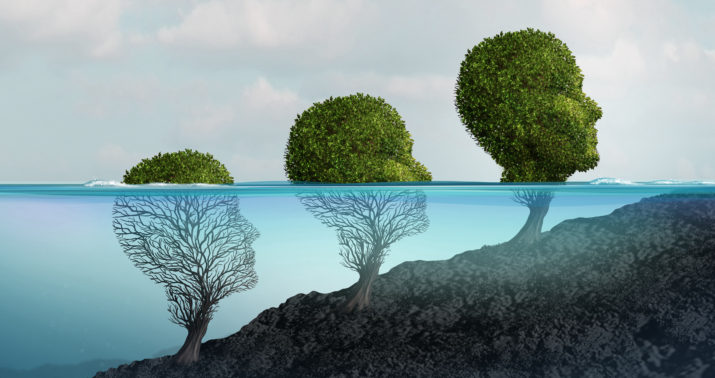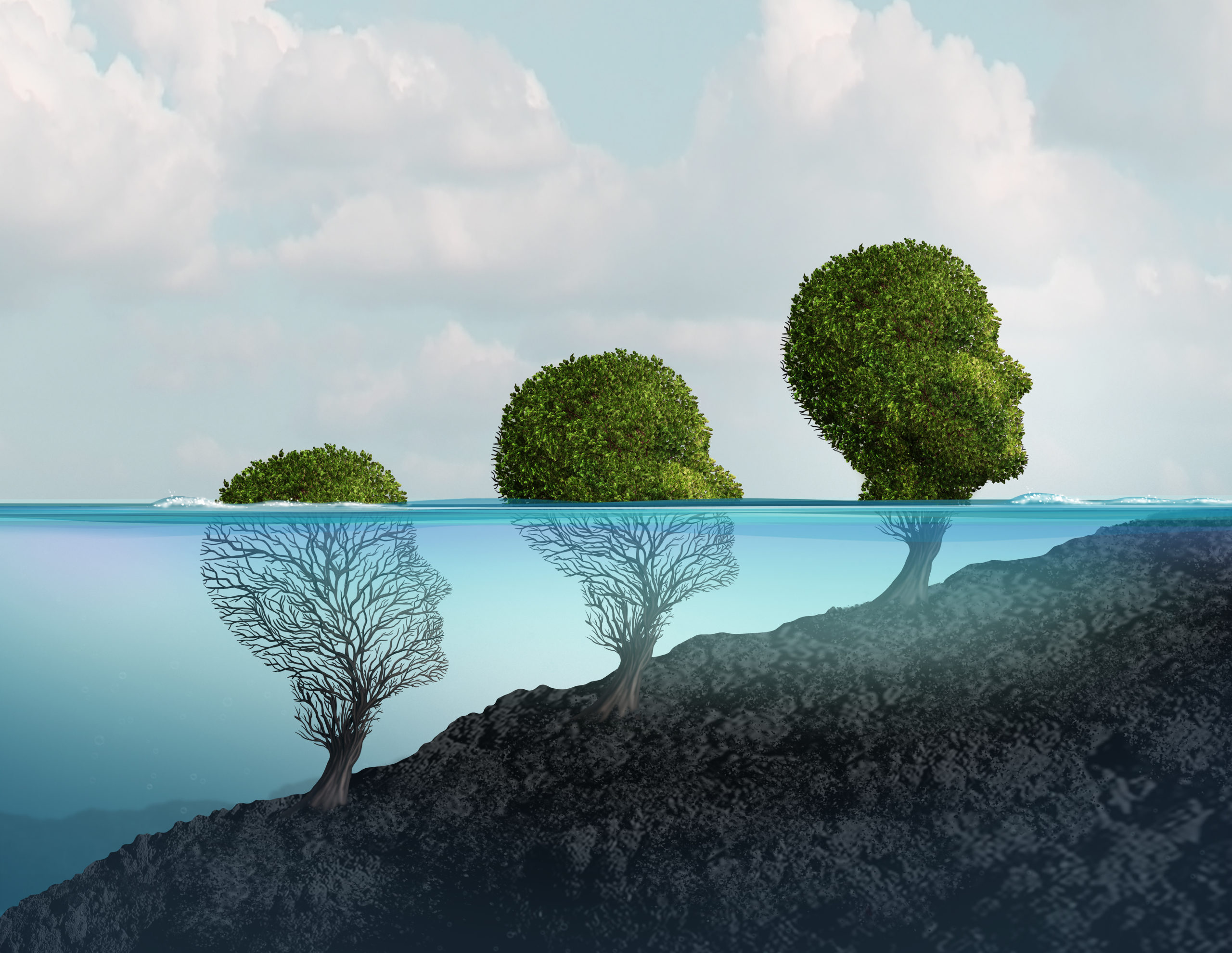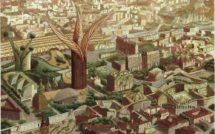

An introduction to our special feature, Rethinking the Human in a Multispecies World.
Contextualizing new approaches to nonhuman worlds in the Anthropocene
Non-human, more-than-human, other-than-human, posthuman, transhuman, anti-human, multispecies, transspecies—all are terms that have been circulating in the humanities and social sciences, but have lacked clarity in their definitions, interpretations, purposes, uses, and range of application. Moreover, this vocabulary is still unfixed, constantly evolving in meaning and content to reflect a dynamic critical intervention about what it means to be human as humanity must face various catastrophes, of which the current pandemic is one embodiment. What these concepts all seek to do is guide us to transform our human self-consciousness around a pluralist ethos that welcomes others’ ideals, voices, perspectives, and modes of experiencing the world. Some scholars even speak of a “turn” to describe the ways in which the disciplines are reorienting their epistemologies away from established anthropocentric, dualistic, and hierarchical approaches (and Eurocentric) to humans’ relationships with the natural and technological worlds (among others, Grusin 2015; Locke and Münster 2015; Bjørkdahl and Parrish 2017; Zolkos 2017; Rieger and Bolinski 2020). In accounting for the Anthropocenic conjuncture, and in particular as captured by climate change as the tangible front of these circumstances, Glenn Albrecht (2005) speaks of solastalgia—a present experience of the loss of a familiar environment that is being damaged—and of “eco-anxiety”—a fear by anticipation that relates to how the future is being perceived (2020). Having fallen to both, humans become homesick even though they are “at home,” i.e. living on a planet from which they feel uncomfortably estranged. He suggests that the Anthropocene—the understanding of a new geological “epoch” where humanity is so dominant that it can modify the planet as much as volcanoes or plate tectonic can—results from humans becoming so powerful that they thought they could distance themselves from a deep relation with the environment. He proposes that the Anthropocene should and will give way to a new age characterized by the appearance of a “Generation Symbiocene.” For the latter, the stakes are high, since, for the philosopher, WWIII will be about the creators of the Earth being pitted against its destructors. In this struggle, the emerging cohort should aim to reconnect with Gaia as a single system by fostering positive emotions towards the Earth.
COVID-19 has brought us at a crossroad in the way we, as humans, relate to each other and to other living realms—accentuating a “thinking with Gaia” (Bonneuil and Fressoz 2016) movement. Escapism from nature, or the ability humans have to “daydream and engage in wishful thinking” in the face of threat (Tuan 1998) appears to no longer be possible. While we are entertained and marveled by foxes and ducks walking European cities and satisfied that levels of biodiversity seem to be on the rise in many areas post-lockdown, the pandemic has also underscored the deep losses we have incurred in detaching ourselves from nature, and has triggered many to look for new relations with “other-than-human” domains of existence. It is within this context that this special feature on “Rethinking the Human in a Multispecies World” provides a sample of the interrogations scholars have developed around this contemporary malaise. Contributors share their outlook on possible solutions to bring equilibrium back to these broken relationships, all explicitly or implicitly also addressing how more attention to inter-species justice could lessen some of the hierarchies that have proven to be detrimental to our environment, and therefore to our own species. As global leaders ponder on the future of the planet at the COP26, this collection points to the importance of interdisciplinarity and collaboration to rebuild our bond with nature in a way that decenters human practices to afford more space for nonhuman voices.
Challenging human-centered perspectives: new concepts and methodologies
In her interview, Francesca Ferrando helps us navigate between various concepts, such as Posthumanisn and Transhumanism, locating them in the history of humanist thought. She points to the pandemic as a prompt for a new awareness in interspecies perspectives and positions the key elements of the debate over what thinking beyond the human can mean in terms of spiritual, emotional, mental, and physical wellbeing, not only for people, but the other species we interact with, whether animal, vegetal, or technological. In deconstructing the notion of species-based supremacy, she invites us to engage with all biological or non-biological beings with joy and care. Her critical posthumanist lens is echoed by Kay Sidebottom, who discusses the “posthumanist turn” in education as involving “a move from the primacy of the written and spoken word to the re-emergence of the embodied self; and a recognition that other-than-human agents are always present in processes of learning.” This pedagogical approach not only applies to the classroom but also to the ways in which knowledge is acquired and organized, as demonstrated in Prudence Gibson’s and Sharon Willoughby’s article on how the history of western taxonomy has been founded on systems of exploitation. Through the story of the Banksia serrata, they show how the naming of plants, which we might take for granted, in fact reflects forms of Eurocentric “mastery, appropriation, and colonization,” not only of nature, but of certain voices—such as Indigenous knowledges. Also looking back at the history of ecology, Sean Ireton shares his research on deep ecology in Norway through the work of Nordic philosopher Arne Næss, pointing to the Norwegian friluftsliv (free-air-life) as a way of being in nature to self-realize beyond the human. This immersion into the natural world is also what Elizabeth B. Jones picks up in her review of the Diary of a Young Naturalist by Dara McAnulty, where the book’s author “understands how to weave together science and literature, mythology, history, and geography, and how to build intimacy with readers through his observations” in and about nature.
Several pieces in this feature delve into the question of what is to be included in our discussion of the nonhuman and how to legitimize our choices through ethical, legal, or political discourses, but also through the development of research methods that support the still contested thesis that nonhumans hold agency. In her article on animal sentience and the law, Shira Shmuely explains how the legislative framework in the UK can serve as an example, albeit still an imperfect one, about how to adopt a more comprehensive attitude towards animal welfare, to include both vertebrates and invertebrates, based on the capacity of these animals to feel pain, just as humans do. As rights have also been attributed to inanimate entities, such as the Amazon or natural landscapes, these legal developments resonate with Matthew D. Miller’s hydrocentric vision of Europe, in which the Danube becomes agent in creating a territory and where “thinking with water, rather than against it or in negligence thereof” brings new forms of inquiry and “greater synchrony with the dynamic character of natureculture in a Europe in flux.” This is also paired with his syllabus on teaching the Danube that structures a multidisciplinary inquiry around the river to examine the region’s longstanding history as a neglected, maligned and contested multilingual, multicultural, and multinational space. While rivers are obvious in our natural landscapes, smaller organisms may be overlooked. Less conspicuous, but no less important, are the lichens that constitute the focus of John Charles Ryan’s essay. As he demonstrates how this micro-organismic system embodies non-dualistic modes of being, he uses poetry to show that “lichenness” participates in doing away with human-centric binaries and “embraces the inclusive potentiality of both/and rather than the oppositionality of either/or.”
From large mammals to tiny insects, all animals have lessons to teach us as we attempt to reimagine our positionality in a posthuman order. Like Ryan, Kathryn Kirkpatrick uses poems to make sense of our relationship with animals—here, bears. She develops a theory and practice of animal poetics to highlight the ways in which poetry can represent nonhuman animals and the way she—as poet-scholar—can write about that representation. Her work fosters a new openness to reciprocal forms of communication with the nonhuman that are also at the center of the article by Richard J. White and Hannah C. Gunderman who concentrate on much smaller animals to encourage a compassionate interspecies mindset and new solidarities toward insects—as teachers, workers, providers, and co-travelers. Based on caring and mutual aid, these new relationships are articulated in the shift from ego- to eco-centrism advocated by Brandon Edwards-Schuth and John Lupinacci in their call for action to disrupt “dualisms that perpetuate value-hierarchized thinking” and for educators to embrace their role to confront human supremacy through the concept of bioregions and ecotistical Earth Democracy.
Skeptics will wonder how research on the nonhuman can yield probative conclusions. While it has been a challenge to mainstream the idea that animals or plants might have agency, it is becoming increasingly clear that the belief that only humans have the ability to plan their reality or “do something extraordinary, namely, ‘see’ what is not there…[as] Seeing what is not there lies at the foundation of all human culture” (Tuan 1998, 6), has been partly discredited by recent works following innovative methodologies. Here, Vicente Raja stresses that plants can modify their behavior when presented with options in a specific and controlled growing environment. His study on plant movement proposes “dramatic implications for our understanding of plants as biological systems, but also as cognitive, or even sentient systems.” Likewise, Charlène Dray and Jocelyne Porcher look at nonhuman agency through the work of stage animals, approaching theatrical performances as co-production with nonhuman participants. They shed new light on inter-species relationships through experimental artistic practice where they are able to record and measure how horses engage in improvisation in the creative process to modify scenographies, away from any pre-written script. These two studies are excellent examples of the kind of work in which scholars are involved to prove the value and necessity of further research on animal and plant cognition, sentience, and nature of their adaptation qualities.
Adopting a posthumanist stance, David Fennell, Bastian Thomsen, and Samuel Fennell add to the effort at devising methods to approach the nonhuman. From their field of tourism studies, they seek to “amplify tourism and animal studies literature through the development of a novel typology, or ‘proto typology,’ designed to classify animals as dark tourism (DT) attractions” and fashion “new ways of doing/being/knowing…that envisage humans and animals as entangled agents…” Others approach this intertwining through the arts—for instance botanical artist Gael Sellwood, whose drawings seek to “inspire humanity’s respect for the vegetal world by fostering strong and lasting emotional bonds between the plant subject and human viewer.” The special feature’s visual exhibit takes Sellwood’s vision even further as body painting artists Gesine Marwedel and Emma Fay, and architect Luc Schuiten imagine new ties with the nonhuman—vegetal or animal—that emphasize a close synergy between shapes and materials in the building of corporeal and urban illusions where the human is no longer the dominant force, having been instead almost absorbed in the artists’ and architect’s expressions of multispecies co-existence. What all these approaches demonstrate is not only different answers to the predicament we are in with regard to the “naturecultural,” but also the breadth of disciplinary relevance in pursuing avenues for developing deeper awareness for our environment and appreciation for all life forms around us.
New frontiers: de-othering artificial intelligence and pushing for more critical engagement
Technology has brought about a new “other” in the form of robotics and autonomous digital tools. Nandita Biswas Mellamphy, like Ferrando in her interview, addresses the question of artificial intelligence (AI) and the role of digital technology in plausible posthuman futures. She rejects the human-centrism that she believes still prevails in narratives of AI, and points to alternative worldviews that dislodge the conceptualization of humans as the “center of agency, cognition, and broader relations/networks of exchange.” Her point is about Posthumanism not going far enough in including AI in its critique. Hers is only one among many critiques of the non-human/post-human/more-than-human movement. Worth mentioning is Paul Gilroy’s contention that: “Those influential formations [posthumanism and anti-humanism] absorbed the impact of colonialism, fascism, and imperialism on the field of ideas. However, neither of them has exhibited much interest in the problems posed specifically by racism, racial hierarchy, and inequality” (Gilroy 2014, 5). While undoubtedly some posthuman thinkers have pondered on this question, including here in this special feature—even if only tangentially—Gilroy’s call for a more forceful engagement with issues of race and racism in conceptualizing a world beyond the human initiates another rich layer of possible and needed investigation to move towards truly inclusive and plural ecologies. Together, the contributors featured in this issue of EuropeNow have laid out a wide array of questioning and some solutions—at least some aspirations. They have certainly presented a convincing and inspiring plea for decentering the human and doing away with human exceptionalism as the only option to meet the demands of the twenty-first century. With Bruno Latour (2018), we ask “Who have we been? Who are we going to become? With whom must we be connected? Where do we find ourselves situated from now on?” Indeed, Ferrando reminds us that finding and crafting our own place in the world, in following the famous γνῶθι σεαυτόν (know yourself), is the best gift we can give ourselves. If we agree that “the twenty first century will be ecological or will no longer be” (Fonbaustier 2021, 93), we should seek to expand the Greek wisdom from the personal realm to that of society and the species as a whole.
Finally, a word of thanks to all who have stepped up to the plate with enthusiasm to partake in this issue of EuropeNow. We cannot acknowledge enough how this past year and a half has been challenging for many of us. I would like to express all my gratitude to the contributors in this special feature who have shown not only their dedication through the process, but also their commitment to the big questions of our time. Their thoughtful engagement in sorting out paths for solutions through a re-hauling of individual and societal relations with other lifeworlds and their invitation to shift from linear, centralized modes of inquiry towards innovative and generous visions for future human-nonhuman relations is inspiring and motivating.
Hélène B. Ducros holds a JD and PhD in human geography from the University of North Carolina at Chapel Hill. Her latest publication is Justice in Climate Action Planning (Springer 2022, with Brian Petersen). She is Lead Editor for the joint World Society Foundation-Council for European Studies writing lab, Chair of Research and Pedagogy at EuropeNow Journal, and Co-chair of the CES Critical European Studies Research Network (Twitter: @CESCritEuro).
Research
- “Self-Realization beyond the Human: Arne Næss and Norwegian Deep Ecology” by Sean Ireton
- “Re-thinking “Human-centric” AI: An Introduction to Posthumanist Critique” by Nandita Biswas Mellamphy
- “In a Europe of Waters” by Matthew Miller
- “From Mules to Cephalopods: The Changing Classifications of Animals Protected from Cruelty” by Shira Shmuely
- “Mastery and the Banksia Tree” by Prudence Gibson and Sharon Willoughby
- “On Becoming Lichen” by John Ryan
- “Moving the Green: Plant Behavior in the Human World” by Vincente Raja
- “Animals as Dark Tourism Attractions: A Prototype” by David Fennell
Commentary
- “Kindness and Compassion for Mutual Flourishing in Post-human Worlds: Re-Imagining our Relationships with Insects” by Richard White and Hannah Gunderman
- “Living with Bears” by Kathryn Kirpatrick
- “Circus Animals: Exploring the Work Relationship through Theatrical Co-production” by Jocelyne Porcher and Charlène Dray
Visual Art
Interviews
- “An Interview about Posthumanism in a Time of Crisis” by Francesca Ferrando, Rohan Hassan, and Hélène Ducros
- “The Plant World from a Botanical Artist’s Perspective: An Interview with Gael Sellwood” by Elizabeth Jones
Book Reviews
- Diary of a Young Naturalist, reviewed by Elizabeth Jones
- Our Gigantic Zoo: A German Quest to Save the Serengeti, reviewed by Yotam Tsal
Campus
- “Pedagogies of Diverse Bioregions: An Ecotistical Move from Ego to Eco” by Brandon Edwards-Schuth and John Lupinacci
- “Education for a More-Than-Human World” by Kay Sidebottom
- “Syllabus: The Danube” by Matthew Miller
Campus Monthly Round-Up
Editor’s Pick
References
Albrecht, Glenn. 2005. Solastalgia: a new concept in human health and identity. PAN Partners.
Albrecht, Glenn. 2020. Les émotions de la Terre: Des nouveaux mots pour un nouveau monde. Paris: Editions Les liens qui libèrent.
Bjørkdahl, Kristian, and Alex C. Parrish. 2017. Rhetorical Animals: Boundaries of the Human in the Study of Persuasion. Washington, D.C.: Rowman & Littlefield.
Bonneuil, Christophe, and Jean-Baptiste Fressoz. 2016. L’événement Anthropocène: La Terre, l’histoire et nous. Paris: Seuil.
Fonbaustier, Laurent. 2021. Environnement. Paris: Anamosa.
Gilroy, Paul. 2014. “Suffering and Infrahumanity.” The Tanner Lectures on Human Values. Delivered at Yale University, February 21.
Grusin, Richard. 2015. The Nonhuman Turn. Minneapolis: University of Minnesota Press.
Latour, Bruno. 2018. An Inquiry into Modes of Existence: An Anthropology of the Moderns. Cambridge: Harvard University Press.
Münster, Ursula, and Piers Locke. 2015. “Multispecies Ethnography.” in John Jackson (ed.), Oxford Bibliographies Online: Anthropology. Oxford: Oxford University.
Rieger, Stefan, and Ina Bolinski. 2020. “Beyond the Anthropocene: Are We Entering a ‘Multispecies Turn’?” Ruhr Universität Bochum IFM Blog. https://ifm.blogs.ruhr-uni-bochum.de/wp-content/uploads/2020/04/StefanRieger_InaBolinski.pdf
Tuan, Yi-Fu. 1998. Escapism. Baltimore: The Johns Hopkins University Press.
Zolkos, Magdalena. 2017. Life as a Political Problem: The Post-Human Turn in Political Theory. Political Studies Review. Volume 16 issue3, 192-204.
Published on November 9, 2021




